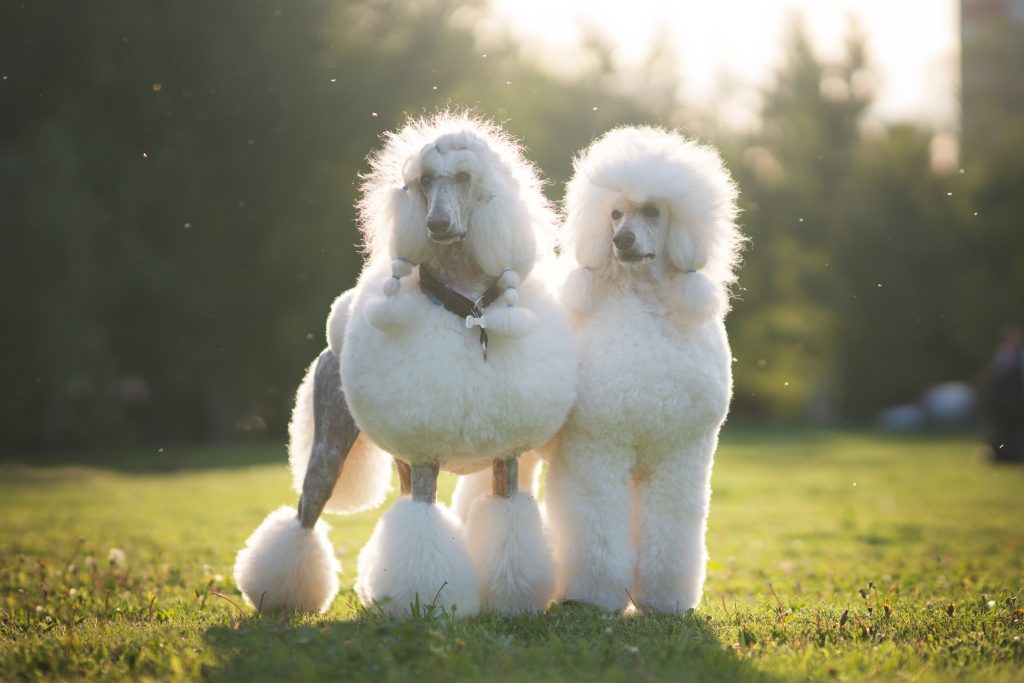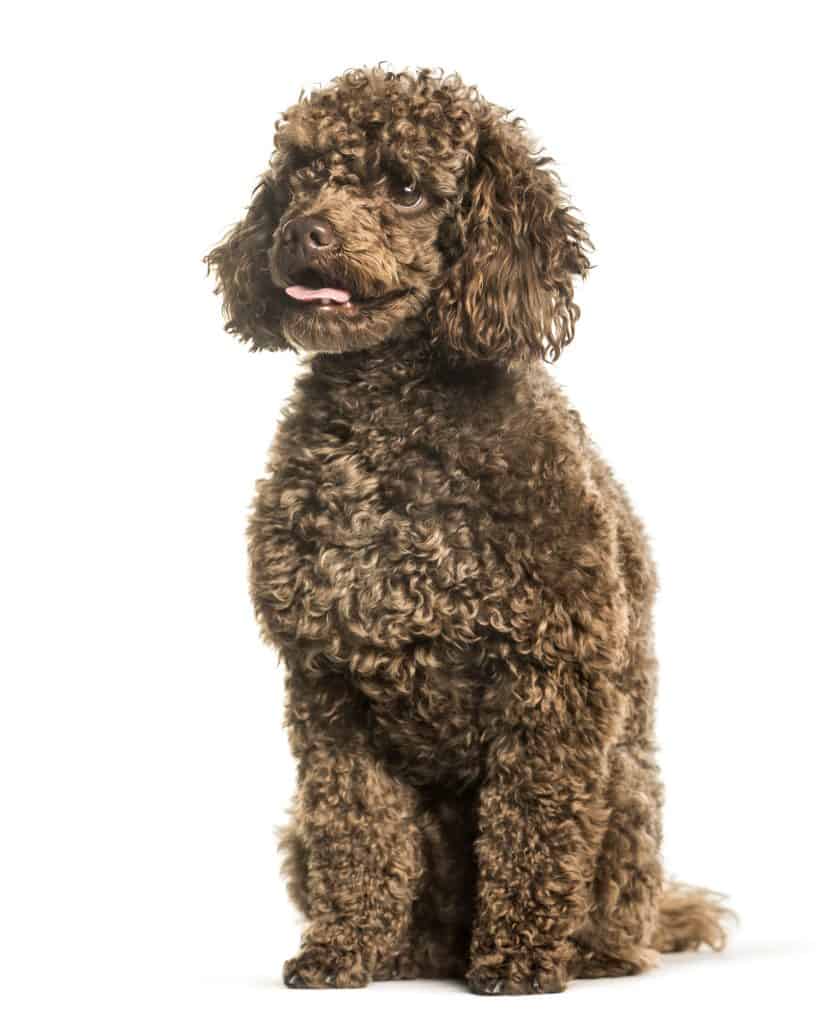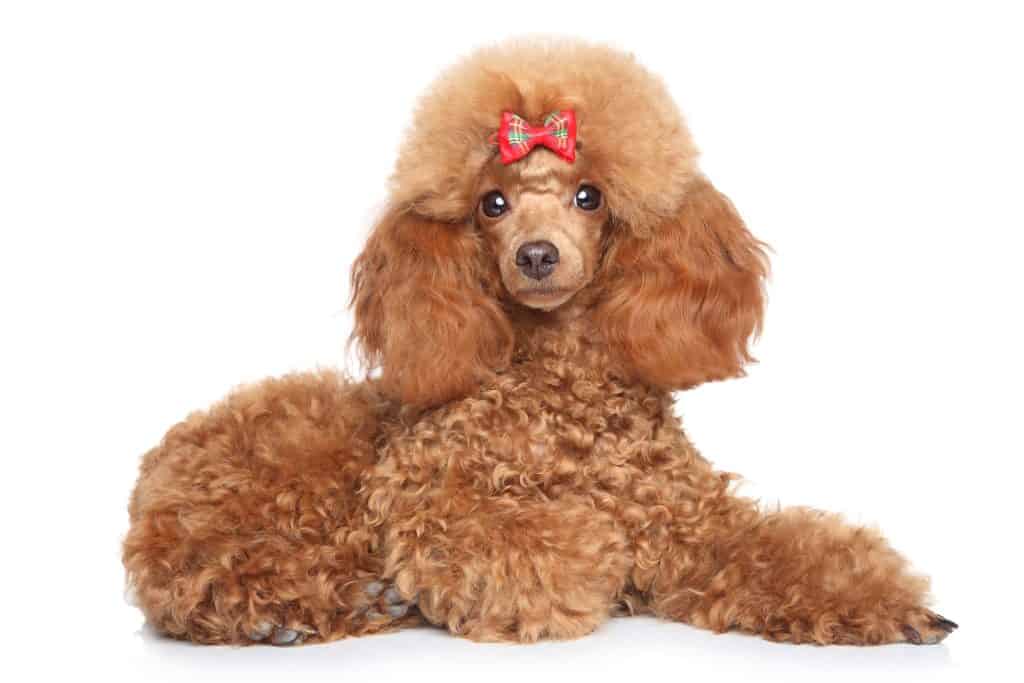As a poodle owner, you might be wondering: what color will my poodle puppies be? Understanding poodle genetics can help you predict the color of your poodle’s future puppies. This comprehensive guide will provide all the information you need about poodle genetics and coat colors.
Table of Contents
What Color Will My Poodle Puppies Be Based on Coat Type?
Poodles are known for their distinct curly coats that are often associated with the breed. However, poodles can also have corded or wavy coats, which can affect the prediction of their future puppies’ coat colors.

Curly coats are the most common coat type among poodles, and they can produce darker puppies. This is because the curly coat type is associated with the presence of the B allele, which can produce black or brown coat colors. Therefore, poodles with curly coats are likelier to have puppies with darker coat colors, such as black, brown, or parti-colors.

Corded coats are less common than curly coats and are characterized by long, thin cords that are formed by matting. Poodles with corded coats are more likely to produce puppies with dark or solid colors, as the cords can mask any color variations. Corded poodles can produce black, brown, or white puppies, depending on the parents’ genetic makeup.

Wavy coats are the rarest coat type among poodles and are characterized by loose, gentle waves. Poodles with wavy coats are likelier to produce puppies with lighter coat colors, such as cream or apricot. This is because the wavy coat type is associated with the absence of the B allele, which produces lighter coat colors.
What Color Will My Poodle Puppies Be Based on Coat Color?
Poodle coat colors are diverse, with shades and patterns that can be predicted through an understanding of their inheritance patterns. Common poodle coat colors include black, brown, white, red, apricot, cream, parti, phantom, and sable.
Black is the most common poodle coat color, and a dominant gene produces it. This means that if one parent has a black coat, there is a high likelihood that the puppies will also have a black coat. Brown is another common poodle coat color produced by a recessive gene. This means that both parents must carry the brown gene for the puppies to have a brown coat.
White is another poodle coat color that is produced by a dominant gene. This means that if one parent has a white coat, there is a high likelihood that the puppies will also have a white coat. Red and apricot are also common poodle coat colors, and they are produced by a combination of genes that include a recessive gene for red.

Cream is a poodle coat color that is produced by a recessive gene. This means that both parents must carry the cream gene for the puppies to have a cream coat. Parti and phantom are two coat patterns found in poodles, and they are produced by a combination of genes that include both dominant and recessive genes.
Sable poodles have a unique genetic makeup that determines their coat color. A dominant gene produces sable coat color, but other genes can also influence it. As a result, sable poodles can have puppies with a range of colors, including black, brown, and red, depending on their genetic makeup.
Understanding Poodle Genetics
To understand poodle genetics, it is crucial to have a basic understanding of genetics concepts. In poodles, genes determine physical traits such as coat color. Therefore, different genes can interact to produce various coat colors.
Dominant vs. Recessive Genes
Dominant genes are the genes that are expressed and determine the physical trait. Recessive genes are not expressed unless paired with another recessive gene. Understanding dominant and recessive genes can help predict the color of your poodle’s puppies.
Coat Color Genetics
Coat color genetics in poodles is determined by a combination of genes that interact to produce different coat colors. The color of a poodle’s coat can be predicted by examining the inheritance of specific genes.
Understanding Alleles
Alleles are different versions of the same gene. In poodles, different alleles can interact to produce different coat colors. Understanding alleles and their interactions can help predict the color of your poodle’s puppies.
Common Poodle Coat Colors
Black, brown, and white are the most common poodle coat colors. These colors have different inheritance patterns, and understanding them can help you predict the color of your poodle’s future puppies.
White Poodles
White poodles are one of the most popular coat colors for poodles. White poodles are often bred for their elegant and sophisticated appearance, and they are commonly seen in dog shows and competitions. However, breeding for white poodles can be challenging, as the white color is recessive and can be masked by other dominant coat colors. Additionally, white poodles can be prone to certain health issues, such as deafness and skin problems, due to their lack of pigmentation. Therefore, responsible breeding practices and genetic testing are crucial for producing healthy and high-quality white poodles.

Black Poodles
Black poodles are a classic and timeless coat color. Black is the most common and dominant color for poodles, and black poodles can range in shades from jet black to a softer charcoal. Black poodles are highly sought after for their elegant and sophisticated appearance, and they are commonly seen in various settings, from family pets to show dogs.

Brown Poodles
Brown poodles, also known as chocolate poodles, are a popular and striking coat color for poodles. Brown poodles range in shades from a light cafe-au-lait color to a deep dark chocolate color. Brown poodles can have various markings, such as white patches on their chest or toes, and they are highly sought after for their unique and stunning appearance. However, breeding for brown poodles can be challenging, as the brown color is recessive and can be masked by other dominant coat colors.

Rare Poodle Coat Colors
Poodles can also have rare coat colors like red, apricot, cream, parti, phantom, and sable. These colors have unique inheritance patterns, and understanding them can help predict the color of your poodle’s future puppies.
Red Poodles
Red poodles are a vibrant and eye-catching coat color for poodles. Red poodles range in shades from a light apricot color to a deep, rich red color. Red poodles can have various markings, such as white patches on their chest or toes. Red poodles are highly sought after for their unique and stunning appearance, and they are commonly seen in dog shows and competitions. However, breeding for red poodles can be challenging, as the red color is recessive and can be masked by other dominant coat colors.

Apricot and Cream Poodles
Apricot and cream poodles are soft and delicate coat colors for poodles. Apricot poodles range in shades from a light, peachy color to a deeper, rusty color. Cream poodles are lighter in color, ranging from pale ivory to creamy white. Apricot and cream poodles can have various markings, such as white patches on their chest or toes. Apricot and cream poodles are highly sought after for their soft and elegant appearance, and they are commonly seen in various settings, from family pets to show dogs.

Parti Poodles
Parti poodles are a unique and eye-catching coat color pattern for poodles. The parti pattern features patches of two or more colors on a white background. The colors can vary widely, ranging from black and white to brown and white, and even red and white. Parti poodles can have a variety of markings and patterns, and they are highly sought after for their unique and stunning appearance. However, breeding for parti poodles can be challenging, as the parti pattern is recessive and can be masked by other dominant coat colors.

Phantom Poodles
Phantom poodle colors are a unique and striking coat color pattern. The phantom pattern features solid patches of one color on a background of another color. Typically, phantom poodles have a base coat color of black, brown, or red with lighter-colored markings on their eyebrows, muzzle, chest, and legs. The markings can range from a cream or apricot color to a silver or grey color. Phantom poodles are highly sought after for their unique and beautiful coat color pattern.

Sable Poodles
Sable poodles are a rare and stunning coat color for poodles. Sable poodles have a unique color pattern where the hairs have multiple colors, often dark at the root and gradually lightening to a lighter color at the tips. The sable color can range from a deep mahogany color to a light fawn color. Sable poodles are highly sought after for their unique and striking appearance, and they are commonly seen in various settings, from family pets to show dogs. However, breeding for sable poodles can be challenging, as the sable color is controlled by multiple genes and can be difficult to predict.

Breeding Poodles for Coat Colors
Breeding poodles for specific coat colors is a complex process that requires careful consideration of genetics and inheritance patterns. Understanding the principles of poodle genetics can help breeders produce poodles with desired coat colors.
To produce poodles with specific coat colors, breeders must first understand the basics of genetic inheritance. Coat color is determined by a combination of genes, with some genes being dominant and others recessive. In addition, each poodle has two copies of each gene, one inherited from each parent.
When breeding poodles for specific coat colors, breeders must consider the genotype of each parent. The genotype refers to the genetic makeup of a poodle and determines which genes are dominant and which are recessive. For example, if a poodle carries two dominant genes for a certain coat color, all of its offspring will also have that coat color.

Breeders must also consider the phenotype of each parent. The phenotype refers to the physical appearance of a poodle and is determined by the interaction between the genotype and the environment. For example, a poodle with a genotype for a certain coat color may not exhibit that color if it is exposed to certain chemicals or if it is affected by a health condition.
To produce poodles with specific coat colors, breeders can use selective breeding to combine desirable traits from each parent. This involves selecting poodles with the desired coat colors and breeding them together to produce offspring with the same coat colors.
However, it is important for breeders to avoid breeding practices that can lead to genetic health issues. Inbreeding and line breeding, for example, can increase the risk of genetic mutations and health problems in poodle puppies.
Therefore, responsible breeding practices are essential to ensure the health and well-being of poodle puppies. This includes using DNA testing to identify potential health issues and avoiding breeding dogs that are closely related or that carry genetic mutations that can cause health problems in their offspring.
Factors That Affect Coat Color

Factors that can affect the coat color of poodles can be numerous and include both internal and external influences. Here are some factors to consider when predicting the coat color of your poodle’s future puppies:
- Age: The coat color of poodles can change as they age. For example, a black poodle may develop gray or silver hairs as it gets older. This is a natural process and does not affect the genetic makeup of the poodle.
- Environment: The environment can also affect the coat color of poodles. Exposure to sunlight can cause a fading effect on some coat colors, such as red and apricot. Similarly, exposure to certain chemicals or shampoos can alter the coat color of poodles.
- Health: A poodle’s overall health can also affect their coat color. Certain health conditions can cause changes in the pigmentation of the coat, such as hormonal imbalances or skin allergies.
- Genetics: The most significant factor affecting the coat color of poodles is genetics. The genetic makeup of the parents determines which coat colors are most likely to be passed down to their offspring. Breeders can use DNA testing to identify the genetic makeup of their poodles and predict the coat colors of their future puppies.
- Breeding Practices: Breeding practices can also affect the coat color of poodles. Responsible breeding practices ensure that only healthy and genetically sound poodles are bred, which can increase the likelihood of producing healthy and desirable coat colors in their offspring.
- Crossbreeding: Crossbreeding can also affect the coat color of poodles. For example, a poodle that is crossed with a Labrador Retriever can produce puppies with a range of coat colors, including black, chocolate, and yellow.
Understanding these factors can help predict the coat color of your poodle’s future puppies. By taking into account their age, environment, health, genetics, breeding practices, and crossbreeding, breeders and poodle owners can have a better understanding of what coat colors to expect in their puppies.
The Role of DNA Testing
DNA testing is a powerful tool that can help breeders and poodle owners identify the specific genes that determine coat color in poodles. By analyzing the DNA of a poodle, breeders can gain a deeper understanding of their genetic makeup, including the genes that influence coat color.
DNA testing can provide accurate predictions of future puppy coat colors by identifying which genes are dominant and recessive. Breeders can use this information to determine the likelihood of producing certain coat colors in their poodle’s future puppies. This can help breeders make informed decisions about which poodles to breed together to produce desired coat colors in their offspring.

Moreover, DNA testing can also identify potential genetic health issues that may be present in a poodle’s genetic makeup. Some coat colors and patterns are associated with certain health conditions, such as white poodles being more prone to deafness. By identifying these potential health issues early on, breeders can take steps to minimize the risk of passing on these genetic conditions to their puppies.
In addition, DNA testing can help prevent unethical breeding practices that can lead to health problems in poodle puppies. By identifying the genetic makeup of a poodle, breeders can avoid breeding dogs that are closely related or that carry genetic mutations that can cause health problems in their offspring.
Conclusion
In conclusion, understanding poodle genetics can help predict the color of your poodle’s future puppies. Different coat colors have unique inheritance patterns, and understanding these patterns can help breeders produce poodles with desired coat colors. DNA testing can also help identify specific genes that determine coat color and potential health issues. As a poodle owner, understanding poodle genetics can help you prepare for the arrival of your poodle’s future puppies and ensure that they are healthy and happy.

